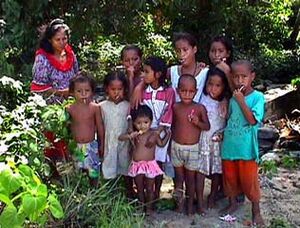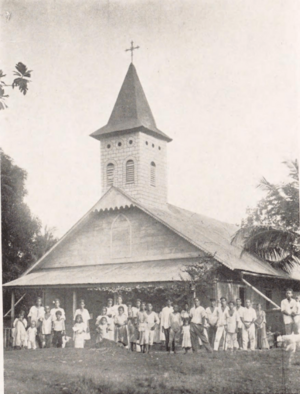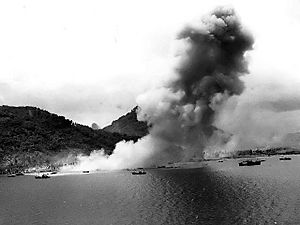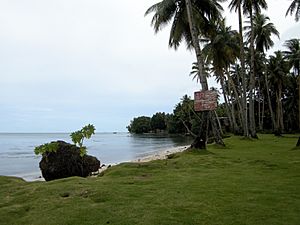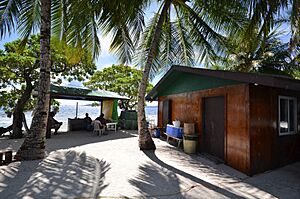Chuuk State facts for kids
Quick facts for kids
Chuuk State
|
||
|---|---|---|
|
State
|
||
|
||
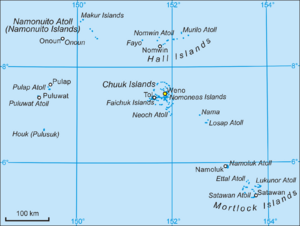
Map of Chuuk State
|
||
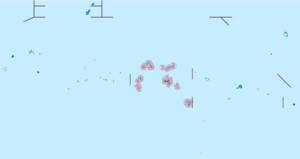
Chuuk in the Federated States of Micronesia
|
||
| Country | ||
| Capital | Weno | |
| Area | ||
| • Total | 121.5 km2 (46.9 sq mi) | |
| Population
(2010)
|
||
| • Total | 48,654 | |
| • Density | 400.44/km2 (1,037.1/sq mi) | |
| Time zone | UTC+10 | |
| ISO 3166 code | FM-TRK | |
Chuuk State (pronounced 'chook') is one of the four states in the Federated States of Micronesia (FSM). The other states are Kosrae, Pohnpei, and Yap. Chuuk is made up of several island groups. These include Namoneas, Faichuuk, the Hall Islands, Namonuito Atoll, Pattiw (Western Islands), and the Mortlock Islands.
Chuuk is the most populated state in the FSM. About 50,000 people live on its 120 square kilometers of land. Most people live in the Chuuk Lagoon. Weno island, located in the lagoon, is the capital of Chuuk. It is also the largest city in the country. Chuuk might hold a vote in the future to decide if it should become an independent country. This vote has been postponed several times.
Contents
History of Chuuk
Early Settlers
The first people to settle in Chuuk were Austronesians. They are thought to have come from the Lapita culture in Island Melanesia. Old discoveries show that people lived on the islands of Feefen and Wééné as early as 100 or 200 BCE. More evidence shows that many settlements appeared in Chuuk around the 1300s CE. This is when the unique Chuukese culture began to form.
Spanish Influence
The first Europeans to see Chuuk were led by Spanish explorer Alvaro de Saavedra. This happened in August or September of 1528. Another Spaniard, Alonso de Arellano, visited the islands on January 15, 1565.
Chuuk was part of the Caroline Islands. The Spanish Empire claimed these islands. However, Spain found it hard to control them in the late 1800s. The Chuuk Lagoon was home to the Chuukese people. They were an Austronesian group who sometimes had small conflicts. There were also a few foreign traders and missionaries, mostly from the Catholic Church. Spain's control over the islands was not very strong. Spain raised its flag over Chuuk in 1886. They returned in 1895 to try and gain more control. They also tried to make peace between the different groups in Chuuk. Spain did not build any large settlements there. Life for the people continued as it had before.
German and Japanese Control
The Caroline Islands were sold to the German Empire in 1899. This happened after Spain lost its main colony, the Philippines, in the Spanish–American War. Germany then made Chuuk part of its territory in German New Guinea.
During World War I, the Imperial Japanese navy was given the job of finding and destroying German ships. They also protected trade routes in the Pacific and Indian Oceans. As part of this, the Japanese Navy took over German lands. These included the Mariana Islands, the Carolinas, the Marshall Islands, and Palau by October 1914. After Germany lost World War I, Chuuk became a territory of the Empire of Japan. This was under the rules of the League of Nations.
United States Administration
After World War II, Chuuk became one of six districts. These districts were part of the Trust Territory of the Pacific Islands (TTPI). The United States managed these islands for the United Nations. The U.S. stopped managing Chuuk, Yap, Kosrae, Pohnpei, and the Mariana Islands on November 3, 1986.
Becoming Independent
The Federated States of Micronesia was formed in 1979. This included Chuuk, Yap, Kosrae, and Pohnpei. They signed an agreement called the Compact of Free Association with the U.S. This agreement became active on November 3, 1986.
Recently, Chuuk has been pushing to become independent. A vote on independence was planned for March 3, 2015. It was then moved to March 5, 2019. The vote was then moved again to March 2022. The exact date will be announced later. This is because they are still checking if leaving the federation is legal.
Geography of Chuuk
To the west of Chuuk is Yap State. To the east are Pohnpei State and Kosrae State.
The main place where people live in Chuuk State is the Chuuk Lagoon. This is a large group of islands with mountains. These islands are surrounded by smaller islets on a barrier reef. The Chuuk Lagoon has two main areas with different dialects. These are Faichuuk, which are the western islands, and Namoneas, the eastern islands.
Chuuk State also has several "outer island" groups. These islands have fewer people living on them. They include the Mortlock Islands to the southeast. There are also the Hall Islands to the north. Namonuito Atoll is to the northwest. The Pattiw Region is to the west. The Pattiw Region is special because it has some of the most traditional islands in the Pacific. Its culture is similar to the outer islands of Yap. This group includes the islands of Pollap, Tamatam, Poluwat, and Houk.
Some traditional master navigators still live here. Poluwat and Pollap are known for having some of the best navigators. They also have great ocean-going outrigger canoes in the Pacific. In the Pattiw Region and some islands of Yap, there are two remaining navigation schools. These are Weriyeng and Faaluush. It can be hard to visit the Pattiw Region in the west. This is because there isn't always reliable transportation. Houk likely has the easiest airstrip to reach in the Pattiw Region. Planes land there every one or two weeks.
Climate
Chuuk has a tropical climate. This means it is warm all year round. It also gets a lot of rain. The average temperature is around 27 degrees Celsius (80 degrees Fahrenheit).
Typhoon Chataan
On July 2, 2002, Tropical Storm Chataan brought very heavy rains. These rains caused over thirty landslides. Landslides are when a lot of earth and rocks slide down a slope. Forty-seven people died and many more were hurt. This was the deadliest weather event in Chuuk's history. The landslides happened throughout the day, sometimes just minutes apart.
People of Chuuk
Chuuk is the most populated state in the FSM. In 2000, it had 53,595 people. By 2010, the population was 48,654.
Religion
Most people in Chuuk are Christian. This is because missionaries came from Spain, Germany, and the United States. Catholicism was brought during the Spanish time. Later, different Protestant groups arrived. The main Catholic church is the Immaculate Heart of Mary Cathedral in Tunnuk, Weno. Other churches include Sacred Heart Church on Lekinioch Island and Holy Family Church in Weno.
Language
The people of Chuuk speak the Chuukese language. This is a Micronesian language.
Culture
Jesuit School in Weno
The Jesuits (a Catholic religious order) run a mission school on Weno island. This school is called Xavier High School. It is located in an old Japanese communications building. It is a school for both boys and girls. Students come from all over the Federated States of Micronesia. They also come from Palau and the Marshall Islands. The teachers are Jesuits and other people. They come from Micronesia, the U.S., Indonesia, Japan, and Australia.
Traditional Beliefs
Even though most people in Chuuk are Christian, some traditional beliefs still exist. One belief is in spirit possession by the dead. It is said that these spirits mostly possess women. This usually happens because of family disagreements. The spirits, speaking through the women, often tell family members to treat each other better.
Municipalities
Chuuk State has 40 municipalities. Sixteen of these are inside the Chuuk Lagoon. The other 24 are in the Outer Islands.
Here are some of the municipalities and their populations from the 2010 Census:
- Chuuk Lagoon (36,158 people)
- Faichuk (11,305 people)
- Tol (4,579)
- Udot (1,680)
- Northern Namoneas (14,620 people)
- Weno (13,856)
- Southern Namoneas (10,233 people)
- Fefan (3,471)
- Tonowas (3,517)
- Faichuk (11,305 people)
- Outer Islands (12,496 people)
- Mortlocks (5,677 people)
- Lukunor (848)
- Moch (932)
- Northwest (6,819 people)
- Poluwat (745)
- Pulap (1,168)
- Pulusuk (1,116)
- Mortlocks (5,677 people)
Politics and Government
Chuuk State is one of the four states of the Federated States of Micronesia. It is a democratic federation. This means each state has a lot of power within its own borders. They also have a certain level of independence, like other federal states. The main leader of Chuuk is the governor. Chuuk also has a legislature with two parts.
Education
The Chuuk State Department of Education runs public schools.
Public high schools include:
- Chuuk High School - Weno
- Faichuk High School
- Moch High School
- Mortlock High School
- Southern Namoneas High School (SNHS)
- Weno High School
Private secondary schools include:
- Berea Christian High School - Weno
- Saramen Chuuk Academy
- Xavier High School - Weno
- Mizpah Christian High School
- Seventh Day Adventist Mission School
Private primary schools include:
- Pentecostal Light House Academy
- Saint Cecilia School
- Seventh Day Adventist Mission School
Tourism in Chuuk
Chuuk State gets the most visitors compared to other states in the Federated States of Micronesia. However, tourism is still growing. A report from 2016 said that tourism in Chuuk faced challenges. These included a lack of good transportation between islands. Also, electricity was not always available on all islands except Weno.
The report noted that Chuuk's underwater attractions are the main reason tourists visit. These include its diverse marine life and the shipwrecks from World War II. Tourism that exists relies on the diving industry. This industry was started by Kimiuo Aisek. To honor his work, the Kimiuo Aisek Memorial Museum was created.
The American attacks on the Japanese fleet in 1944 were very strong. Because of this, Truk Lagoon is now the largest underwater military cemetery in the world. It has 60 ships and 400 aircraft spread out over several kilometers. This attracts divers from all over the world. The diving conditions are excellent. Visibility is good, currents are minor, and there are 700 types of fish and lots of coral. However, this source of income is at risk. The shipwrecks are breaking down quickly. Also, dynamite fishing is destroying parts of this underwater graveyard.
See also
- Chuuk Women's Council, a group that works for women's rights in Weno.
- Habele, a charity that helps with education in Chuuk.
- Chuukese independence referendum, a vote for Chuuk to become independent from Micronesia. This vote has been delayed several times.
Images for kids



